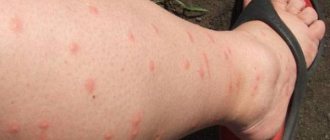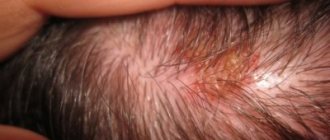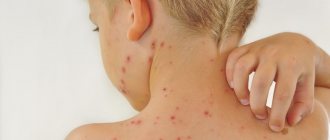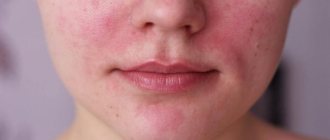Hives on the buttocks
A person’s health is the most valuable thing he has.
Any manifestations of ailments bring discomfort and anxiety, a feeling of depression, especially for young women, if the disease manifests itself in appearance.
A rash on the butt in an adult is no exception and indicates the presence of some disease.
The skin on the buttocks is quite delicate, so this is where various rashes appear, caused by external factors or viruses.
Types of buttock rashes
The following types of rashes are distinguished:
- 1. Spots - areas with different pigmentation, shape, size and localization, without elements of swelling, at the same level as the skin. Most often, spots on the butt are red. If there is hemorrhage under the skin, then we speak of hematoma, ecchymosis, if the value is more than 1 cm, and petechiae, when pinpoint hemorrhages are less than 1 cm.
- 2. A papule is a nodule, a cavityless formation inside the dermis, usually its size does not exceed a millet grain or lentil. Blisters are rough formations, slightly raised above the skin, and can be dense or contain liquid.
- 3. Bubbles are cavity formations with transparent contents. They protrude above the skin; when small, they are called vesicles; when large, they are called bullae.
- 4. Pustules are the same blisters, but filled with pus and dead skin cells. Protrude above skin level.
- 5. Acne is often associated with blockage of the sebaceous glands, they look like dense inflammatory formations on the skin, when squeezed, the dark contents are squeezed out, they are painful.
- 6. Scales are formed in the stage of crusts on their surface; they are secondary.
- 7. Erosions have different sizes and depths and occur at the site of skin damage with other skin elements. They have their own discharge, often cloudy, which can be with or without odor.
- 8. Crusts appear during the healing stage of ulcers or erosions during recovery. Secondary.
Causes of the phenomenon
The causes of acne on the butt are very different from the generally accepted ones, this is explained by the characteristics of the skin on the buttocks:
- 1. This area of the body is always covered with clothing, and oxygen access is limited. Therefore, it is advisable to arrange air baths for this part of the body.
- 2. There are very few sebaceous glands on the skin of the buttocks, and men do not have them in this place at all, so the skin does not naturally moisturize, it is always dry, which causes a rash on the buttocks in adults and adolescents in the form of acne and inflammatory reactions upon contact with external stimuli.
- 3. There is no self-cleaning of dead epidermal cells, which also provokes inflammation. Dead cells clog the pores and increased keratinization occurs.
- 4. Due to constant prolonged sitting, friction of the skin of the butt on the surface of the chair occurs, which leads to inflammation and rash. This disrupts blood circulation in this area of the body.
- 5. Systematic overheating with sweating causes blisters, hypothermia causes boils on the skin of the buttocks.
- 6. Allergic reactions. Their causes are contact with various allergens (foods, care products, clothing, etc.).
- 7. A rash on the buttocks of an adult can occur if hygiene rules are not followed.
- 8. Long-term use of certain medications, especially antibiotics and hormones.
- 9. Very rarely, a rash on the butt is caused by an STI.
- 10. Eating disorders, drinking alcohol in excessive quantities. Alcoholization disrupts the functioning of the liver, and this ultimately always causes blisters to appear on the skin of the butt.
- 11. Gastrointestinal pathologies, endocrine disorders, while the skin can become either dry or oily (seborrhea).
- 12. Hormonal imbalances, which immediately cause a rash to appear, often on the butt.
- 13. Obesity, hot climate, intense exercise, spicy food, and alcohol can cause itching between the buttocks.
The rash is also caused by various diseases. For convenience, they are divided into 2 large groups - infectious and non-infectious.
Rash on the buttocks in an adult: photos with explanations of various rashes on the buttocks
A rash on the buttocks in an adult indicates the presence of pathological changes in the body. Often the rashes cause mild or intense itching caused by fungi or bacterial infection.
Sometimes an allergic reaction is a consequence of neurodermatitis, psoriasis or folliculitis. It leads to serious discomfort and periodic pain, which makes it difficult to lead a normal lifestyle. In this article we will analyze the types of various rashes and tell you how to get rid of the discomfort they cause.
Rash on the buttocks in women: causes
The gluteal region has a well-developed subcutaneous fat layer containing sebaceous glands. Therefore, rashes on the buttocks are mostly typical for women rather than for the stronger sex. The affected part of the skin turns red, red spots form on it, and slight swelling appears.
Causes of the rash include:
- stressful situations;
- pregnancy;
- poor nutrition;
- liver diseases;
- allergy;
- diabetes;
- hormonal imbalance.
Rash on the buttocks in men: causes
Irritation on the butt occurs due to the characteristics of the male skin. The sebaceous glands on the buttocks produce an insufficient amount of subcutaneous fat, so the skin area becomes susceptible to various pathologies.
Another reason lies in an unbalanced diet and insufficient hydration. Excessive consumption of junk food and dry skin contribute to a manifold increase in the number of acne.
Neglect of the rules of personal hygiene has an impact on the rapid clogging of pores and the sudden formation of a rash with purulent inflammation.
Itching on the buttocks can occur due to the difficulty of oxygen supply to the skin, because it is often covered with several layers of dense tissue. Contact with the upholstery of sofas, chairs and vehicle seats makes the situation much worse.
Irritation on the butt in adults: symptoms
If red dots appear on the buttocks, then this is not a reason to panic. They can act as a response to sudden changes in air temperature. A weakened immune system, constant stress, prolonged overwork on a systematic basis, as well as a lack of walks in the fresh air affect physical condition.
Allergy to the buttocks
The allergic type of rash is associated with a malfunction in the body of an adult. The rash may be temporary. In rare cases, an allergy to the butt worsens and takes on a dangerous form when single nodules unite into foci of inflammation.
To avoid complications, you should consult a specialist who will conduct an examination and prescribe appropriate treatment.
Hives
Hives usually mean raised patches of itchy skin affecting the buttock area of the body. It is clearly toxic and allergic in nature and appears due to insect bites, exposure to bacteria and factors such as heat, cold and sunlight.
The disease is not contagious, so it is impossible to transmit it to another person.
In addition to metabolic disorders and deterioration of the thyroid gland, urticaria provocateurs include tumors, blood vessel diseases and entire groups of autoimmune diseases.
Prickly heat
Miliaria are small blisters on the butt that are common in people who are overweight and have excessive levels of sweating.
High body temperature, dirty skin and profuse sweating are the main factors that cause irritation on the buttocks.
Sometimes an illness signals the presence of problems with the endocrine and nervous system, so it is worth visiting a competent doctor. There are more than enough reasons for the occurrence of prickly heat:
- excessive physical activity;
- wearing tight synthetic clothing for a long time;
- long exposure to the open sun;
- high body temperature during a cold.
Ulcer
Often, folliculitis goes away without outside help. However, in situations of rapid spread of foci of infection, boils may form. Only antibiotics can cure them.
The skin in the buttock area is very sensitive, and therefore prone to various types of infections, which are not always noticeable.
People who prefer a sedentary lifestyle are more prone to this problem. The disease can progress, affecting the skin with numerous ulcers.
Red rash
A rash on the butt is very common among adults, since the buttocks are constantly exposed to elevated temperatures, which distracts a person from normal life activities.
The rashes cause certain inconveniences associated with an unpleasant feeling of discomfort, itching, and wetting.
These can be spots, nodules, ulcers, occupying an area of five square centimeters.
Redness is observed after a long course of treatment with antibiotics and hormonal agents. Disruption of the functions of the endocrine system, obesity, neglect of personal hygiene rules, drinking alcohol, and systematic hypothermia also entail negative consequences and form a red spot on the buttock.
Red pimples
The occurrence of acne is caused by pathologies in the activity of the sebaceous glands, leading to bumpy rashes. A similar rash on the buttocks is extremely rare, which indicates the dense structure of the dermis. If the skin itches and peels, this indicates an imbalance of hormones and an allergic reaction.
Most red pimples are swollen and contain pus.
Squeezing them out is strictly prohibited - this may worsen the situation. It is recommended to visit a dermatologist who will identify the root of the problem and solve it.
Rash between buttocks
The perineum between the buttocks is more susceptible to the appearance of a rash. Some of the main reasons include:
- infectious diseases caused by bacteria, herpes, smallpox, lichen;
- skin diseases;
- taking medications;
- allergy;
- increased rubbing of the dermis;
- chronic irritation.
Based on the causative agent of the disease, blisters are divided into painful and itchy. The speed of the disease directly depends on its source. Sometimes the rash goes away on its own in a matter of days. In other cases, this may take weeks or even months, and will require the help of a specialist.
Other diseases
A rash in the buttock area may be accompanied by a disease such as mycosis. A parasitic fungus affects the intimate area, leading to unbearable itching and nagging pain.
It is easy to become infected - you only need direct contact of the pathogen with the damaged area of the skin. Simply visiting a sauna, steam bath or swimming pool can also cause infection.
Mycosis is typical for people with diabetes and HIV infections.
Another reason for the appearance of an intense rash is scabies. Infectious itching, which is caused by scabies mites, entails an inflammatory reaction. At night, the tick is especially active, thereby causing constant fatigue and insomnia.
In order to get rid of scabies, you need to immediately visit a doctor, start a course of taking special medications and disinfect your bed linen.
How to cure rashes on the butt?
Faced with such a serious and unpleasant problem, everyone thought about how to treat the rash. There are two treatment options: with medications and traditional medicine.
Antiseptic agents that are used to wipe the affected part of the body for several days can get rid of itching and stop the inflammatory process. The main assistants in this matter are salicylic acid, hydrogen peroxide and chlorhexidine.
Do not forget that therapy is prescribed by a specialist after an examination and identification of the nature of the rash.
In order to eliminate irritation, it is enough to use salicylic-zinc ointment.
Small rashes, ulcers, pimples are treated twice a day - morning and evening.
An alternative is Baziron ointment, which has antibacterial properties.
Compared with the use of salicylic ointment, the course of treatment with Baziron takes longer, which has a noticeable impact on safety.
The skin instantly absorbs the medicine, so there is no dryness. Its action reduces the secretion of sebaceous glands, reduces redness, and cleanses pores.
For people trying to save their own time, Skinoren will be a real salvation. The product is available in the form of ointment and gel. The drug is used before bedtime, applying a thin layer with smooth and gentle movements.
The approximate course of treatment is 30 days.
One of the most effective medications is Lassara ointment. It is used to treat acne in people with excessive sweating. Antiseptic and drying properties eliminate foci of infection and stop the inflammatory process. However, the drug has contraindications - pregnant and lactating women should not use the ointment.
How to remove buttock rashes at home?
Not only medications help in treating rashes. Traditional medicine also solves a delicate problem. For some people, applying a warm compress to the affected area of skin is enough. The procedure will relieve inflammation, eliminate pain and ensure rapid healing.
Applying Aloe Vera gel heals wounds, soothes irritated dermis and removes rashes. To use, you need to chop the stems of the plant, and then rub it into the skin of the buttocks in a circular motion so that no discomfort occurs.
You can speed up tissue regeneration by taking a bath with two glasses of thoroughly mixed oatmeal. You need to use this method at least 2-3 times weekly.
A regular trip to the solarium will get rid of the rash, eradicating the source of the problem. The device is equipped with special lamps that emit ultraviolet light.
Solarium has a beneficial effect on the affected areas of human skin: it allows you to dry out inflammation and reduce its number.
Competent treatment of rashes should be carried out comprehensively and combine two approaches. An experienced specialist will prescribe specific medications. If you take them in combination with folk remedies, then achieving a successful result will not be difficult.
Source: https://topallergy.ru/zabolevaniya/krapivnica/syp-na-pope-u-vzroslogo.html
Infectious manifestations
Syphilis - rashes may appear in the second stage; they are localized more around the anal area. The rash is often spotty, symmetrical, bright and abundant, it does not cause any discomfort and disappears without a trace within 2 months. Later it may appear again, but more faded and in smaller quantities.
Pityriasis versicolor is caused by a fungus and is more common with hyperhidrosis. Yellow-brown dots first form around the hair follicles, then they transform, turning into scalloped spots, peel off, become covered with scales, and are very itchy.
Molluscum contagiosum is a shiny translucent spherical nodule with an umbilical depression in the center. Can be pink, grayish, up to pea size. When pressed, a white pulp is released from the nodules. There is no itching.
Herpes appears more often on the genitals in women, and on the butt in men. In this case, tightly bound groups of vesicles appear caused by HSV, they are swollen and constantly itchy. After 2-3 days they burst, the contents become cloudy, then they dry out, forming crusts - yellow or dark brown.
Lichen planus is caused by a fungus. Symmetrical chains, rings, and garlands of nodules appear on the butt; they are accompanied by pain and itching, causing irritation on the butt. In addition to the buttocks, the genitals, inner thighs and arms are affected.
Genital warts are similar to warts and are caused by HPV. Favorite places are the genitals and buttocks. The formations are soft, moist, their surface is pink, they are uneven, and look like cauliflower. They tend to grow very quickly: within a few hours they increase to a whole colony. Condyloma itches.
Scabies. With this disease, micro-holes appear on the skin, and bubbles and blisters may be observed. Micropassages look like whitish-gray lines, up to 1 cm in length, they rise above the skin. They end in a vesicle and are accompanied by severe itching; irritation on the butt is especially worse at night. Treatment: acaricidal drugs - Benzyl benzoate, sulfur ointment, Yurax, Spregal.
Rubrophytosis is of fungal origin. Appears as rashes on the buttocks over their entire surface in the form of small red blisters.
Fungal dermatitis is accompanied by peeling skin between the buttocks. With this form, a whitish coating and peeling are noted on the skin, and there may be blisters and pustules along the edges of the rash. Often develops after long-term treatment and antibiotic use.
Non-infectious rash
Allergic dermatitis is a rash on the butt in the form of a small red papular rash, which then turns into blisters with a yellowish liquid. They open up and erosions appear. Severe itching occurs.
Drug toxicoderma manifests itself as red spots on the buttocks, the course is chronic. This allergic inflammation of the skin occurs when certain medications are administered.
Psoriasis - the appearance of bright pink spots with silvery scales, constant itching on the buttocks. If left untreated, wet cracks in the skin may appear.
Miliaria - on the buttocks there is often an apocrine appearance. Localized around the anus and genitals. Small pink and red pimples form on the butt and subcutaneous lumps (infiltrates). These formations burst and serve as bait for various pathogens when the infection penetrates into the deeper layers of the skin. There may be itching between the buttocks.
A furuncle is an inflammation of the skin around the hair follicle. First, a red, painful spot appears, then it turns into a papule, in the center a core is visible - a purulent head. It gradually matures and after a few days bursts, pus comes out. All this is accompanied by a deterioration in the general condition, pain, and tension at the site of the boil. The area then heals to form a scar. The sore may itch. You cannot squeeze it out yourself; you need to disinfect the skin around the boil by lubricating it with salicylic alcohol, then apply Vishnevsky ointment or ichthyol ointment, which will facilitate the rapid release of pus. When the temperature rises, antibacterial treatment is necessary.
Itching between the buttocks is a very common symptom. It appears as a result of helminthic infestation, occurs at night, with sexually transmitted infections, diabetes, poor hygiene, anal injuries, paraproctitis, inflammation of the genitals - these are the main reasons, it also happens when wearing thongs or tight underwear of a small size.
Treatment of herpes on the buttocks
Before starting treatment for the disease, the dermatologist conducts an initial examination of the patient’s skin condition. The same manipulations can be performed by an infectious disease specialist or venereologist. After a visual examination, the patient must donate blood from a vein to determine the presence of antibodies that react to the presence of a herpes infection. Having the test results in hand, the attending physician forms an individual course of treatment. In order to suppress viral activity in the buttocks area and the entire body as a whole, an integrated therapeutic approach is always used. The patient is prescribed the following medications:
- Acyclovir, Valacyclovir. These drugs interrupt the cell division cycle of the virus and have a restorative effect on already infected tissues of the body. Immunity increases the level of resistance to disease and the healing process accelerates.
- Inosine. This is one of the antiviral spectrum medications that is effective against herpes types 1 and 2. It not only suppresses the virus, but also has immunomodulatory properties.
- Acyclovir, Zovirax, Herpferon, Celestoderm. These are topical ointments that are applied to cold sores to prevent them from transforming into bright red, liquid-filled blisters. These drugs not only locally suppress viral cells, but also relieve inflammation and dry out weeping formations.
- Claritin, Desloratadine. These antihistamines are used in the course of treatment to relieve severe itching and burning sensations. In most cases, the cause of damage to herpetic blisters on the butt occurs with the fingers of the patient himself, as they are very itchy.
- Arbidol, aloe juice, pharmacy tincture of golden root, ginseng, Kagocel. All these drugs have an immunomodulatory effect on the body. The immune system is saturated with nutrients and more successfully resists herpes. As a rule, drugs in this group are prescribed for a long term, since they act as a biological additive to maintain the patient’s vitality and prevent relapse of viral manifestations.
It is important to remember that during the period of treatment for herpes on the butt, the patient’s intimate life is strictly prohibited.
Even the use of barrier contraceptives in the form of a condom does not provide a 100% guarantee that infection of the surrounding skin tissues will be avoided. The patient should change his underwear daily. Wear clothes only from natural fabrics and avoid synthetic trousers. If a person with a herpetic rash on the buttocks lives in a family with small children, then it is better to isolate him for the period of therapy. Children do not yet have strong immunity and are very susceptible to infection with herpes virus genotypes 1 and 2.
Prevention of the disease is to maintain a healthy lifestyle, avoid sexual relations with a large number of sexual partners, and periodically donate venous blood to determine the presence or absence of the virus in the body. Young people who want to become parents must undergo tests before starting a family to rule out the birth of an infected child. You also need to understand that treating herpes on the buttocks at home rarely brings a positive therapeutic effect and can cause serious complications.
First aid
A universal remedy in this case is a bath with a decoction of herbs. The product is prepared from chamomile, string, sage, celandine, oak bark, and calendula. You need 1 glass of this decoction on the pelvis; the buttocks should be immersed in water when sitting. The duration of the procedure is no more than 20 minutes. After this, without rinsing, pat the skin dry with a towel. If the formation on the skin itches, such a bath relieves irritation, itching and inflammation, and promotes healing. You need to take a shower with baby soap twice a day.
Folk remedies
Folk remedies include herbal baths, steaming in a bathhouse and sauna with a birch or juniper broom. Compresses made from plantain, burdock, and aloe pulp are very effective. They are usually applied for 2 days for the effect to appear. Any treatment at home should only occur after a doctor’s prescription.
A few useful tools:
- Tea tree and coconut oil – has high antimicrobial activity. These products will help relieve inflammation and itching for any etiology; they also have a drying effect.
- An oatmeal bath has a calming effect.
- Aloe vera gel has an anti-inflammatory effect and a soothing effect.
- Apple cider vinegar should be diluted halfway with water. Lubricate pustules and wounds.
- Garlic affects both bacteria and viruses. It is necessary to press it into a paste and apply it to the ulcers for 20 minutes, then rinse with warm water. Course – 2 weeks.
- Baking soda is applied as a thick paste and has antimicrobial and drying properties. Neem oil is considered an antiseptic and also affects fungi. Treats blisters well and quickly.
- Turmeric powder is a natural antioxidant, antiseptic and anti-inflammatory drug. Applied to the blister as a paste, it speeds up healing.
A rash on the buttocks in women and girls may be associated with the material of their underwear. It is necessary to minimize the time you wear synthetics.
What not to do?
You cannot self-medicate without special education. Under no circumstances should you squeeze pimples, pierce blisters, rip off scabs, or scratch itchy areas. There is a risk of infection and its spread. The skin around the pimple should be disinfected: it is wiped with an antiseptic several times a day - Salicylic alcohol, Chlorhexidine, Hydrogen Peroxide. Seeing a doctor is mandatory for correct diagnosis.
Necessary treatment
If there are no other symptoms, then after the doctor’s permission, you can try to treat fresh, uncomplicated acne at home: lubricate the pimples with a cotton swab with Salicylic ointment in the morning and evening; you can replace the ointment with iodine or Baziron ointment. It has an antibacterial effect, is well absorbed and does not dry out the skin.
No peelings or sponges! You can also wipe acne with Miramistin. The aniline dye Fukortsin has an antibacterial effect - it must be applied pointwise to each pimple. Pimples need to be dried; Zinc ointment, Skinoren cream, Zinerit, Lassara paste are suitable for this. The procedure with Darsonval helps a lot.
Among ointments for rashes, Bepanten, Cycletal, Desitin, Tsindol, and Salicylic ointment are widely used today. They remove inflammation and rashes on the buttocks and promote healing. It is very useful to use tar soap, which has antibacterial and regenerating properties. If the origin of the rash is allergic, then it will be necessary to prescribe antihistamines: Suprastin, Diazolin, Claritin, Tavegil.
How to treat a rash on the buttocks
Treatment in hospital
After diagnosing the disease, specialists prescribe appropriate treatment.
In some cases, examination of the patient's internal organs and additional research may be necessary to determine the root cause of the rash.
If experts have determined that the cause of the rash is an infectious or allergic lesion, then treatment should take place in a hospital, where potent medications are used to eliminate the problem.
Here the course of treatment will be aimed at eliminating the underlying cause of the disease, which led to the appearance of the rash.
Treatment can be carried out at home, but only in accordance with the doctor’s prescriptions and under his strict supervision.
Drug treatment is presented as follows:
- If the rash has just appeared, you can treat the skin with an iodine solution - this is an aggressive mixture, after which peeling of the skin may begin, through which you can get rid of the pustular rash and other blisters.
- Salicylic ointment helps well, which should be applied to each individual pimple with a cotton swab 2 times a day. But long-term treatment with this ointment is excluded, since you can get burns.
- The drug Baziron-gel, which has antimicrobial properties and does not dry out the skin, has a beneficial effect on the treatment of rashes.
- Miramestin and Fukortsin - these drugs will help you quickly get rid of acne. Moreover, Fukortsin must be applied carefully to each pimple and not put on underwear until completely dry, since the presented product contains coloring components.
- At night, zinc ointment, Skinoren cream or Lassara ointment should be applied to the buttocks.
- To dry out weeping erosive plaques, a visit to the solarium is recommended - 2-3 sessions are enough.
During the period of rash, you should avoid using a washcloth, various scrubs and anti-cellulite creams. It is necessary to shower twice a day using baby soap.
After it, you can apply a thin layer of Bodyaga FORTE gel to the buttocks for 20 minutes, after which the composition is wiped off with a damp cloth or washed off with water. The gel contains only natural ingredients in the form of herbs, which allow you to quickly get rid of bruises and blood congestion.
In the same case, the product increases blood supply to sedentary buttocks, resolves infiltrates and provides bactericidal treatment of acne. Using tar soap will also relieve inflammation, dry and disinfect.
It is necessary to soap the buttocks every time after bathing and leave until completely rashed.
All treatment should be based on the recommendations of the attending physician. Any deviations are fraught with complications.










